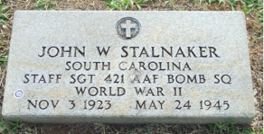Scroll of Honor – John Walker Stalnaker
Target Tokyo
The night was filled with the roar of more than two thousand powerful Wright-Cyclone 2,200  horsepower engines as the bombers lined up along the miles of Tinian’s taxiways. Five hundred sixty-two B-29 Super Fortresses assigned to the mission would begin taking off at 2100 hours, turn north, and fly fourteen hundred miles above the trackless Pacific Ocean to strike the target: Tokyo. Staff Sergeant John Walker Stalnaker of Ninety Six, a member of Clemson College’s interrupted Class of 1946, was the flight engineer on the B-29 nicknamed The Gamecock.
horsepower engines as the bombers lined up along the miles of Tinian’s taxiways. Five hundred sixty-two B-29 Super Fortresses assigned to the mission would begin taking off at 2100 hours, turn north, and fly fourteen hundred miles above the trackless Pacific Ocean to strike the target: Tokyo. Staff Sergeant John Walker Stalnaker of Ninety Six, a member of Clemson College’s interrupted Class of 1946, was the flight engineer on the B-29 nicknamed The Gamecock.
Stalnaker had enrolled at Clemson as an architecture major in the late summer of 1942. The United States was already at war and rumors about the cadets’ futures ricocheted all around campus. In the middle of the spring semester of 1943, the rumors were swept away by fact. All underclassmen would be ordered to active duty at the end of the academic year.
Stalnaker found himself in the Army Air Force. He trained on the most complex and expensive weapons system of World War II, the B-29 bomber, the development of which, at $3 billion, exceeded even the cost of the top-secret Manhattan Project with which it would soon be linked. The B-29 had been engineered by Boeing to meet Army Air Force needs for a longer range bomber to cover the vast distances encountered in the Pacific Theater. The aircraft was bigger, faster, could carry more bombs, and fly greater distances than the B-17s and B-24s used in Europe. It combined a pressurized cabin with state-of-the art weapons systems, including a centrally-controlled gunnery system that allowed two men to operate four machine gun turrets.
The May 23, 1945 raid would feature the largest number of B-29s to take part in a single mission in the entire Pacific war. Stalnaker’s B-29 was manned by a crew of eleven and was piloted by Second Lieutenant Robert T. Boggan. Stalnaker’s position was directly behind the copilot in the aircraft’s forward compartment. His job included the in-flight monitoring of the four sophisticated engines as well as all the other mechanical, hydraulic, and electrical systems on the aircraft.
in the entire Pacific war. Stalnaker’s B-29 was manned by a crew of eleven and was piloted by Second Lieutenant Robert T. Boggan. Stalnaker’s position was directly behind the copilot in the aircraft’s forward compartment. His job included the in-flight monitoring of the four sophisticated engines as well as all the other mechanical, hydraulic, and electrical systems on the aircraft.
The objective for the mission was Tokyo harbor. The bombers would drop incendiary bombs from altitudes of eight to eleven thousand feet. Arriving over the target from the west in the early hours of May 24, the bombers were greeted by an estimated one hundred fifty searchlights, a few enemy fighters, and intense anti-aircraft artillery fire. In clear weather, with good visibility, many of the aircraft were struck and damaged by enemy fire. Stalnaker’s bomber was one of these.
The Gamecock took a direct hit in its number four engine. Boggan was unable to control the aircraft.  Three members of the crew—all gunners with duty positions farther to the rear of the aircraft—were able to bail out of the stricken bomber. They were captured by the Japanese and spent the remaining three months of the war as POWs. The other members of the crew, including Stalnaker, were killed.
Three members of the crew—all gunners with duty positions farther to the rear of the aircraft—were able to bail out of the stricken bomber. They were captured by the Japanese and spent the remaining three months of the war as POWs. The other members of the crew, including Stalnaker, were killed.
After the war, Stalnaker’s remains were returned to the United States and reinterred at Elmwood Cemetery in Ninety Six.
For more information about John Walker Stalnaker see:
https://soh.alumni.clemson.edu/scroll/john-walker-stalnaker/
For additional information about Clemson University’s Scroll of Honor see:
https://soh.alumni.clemson.edu/
